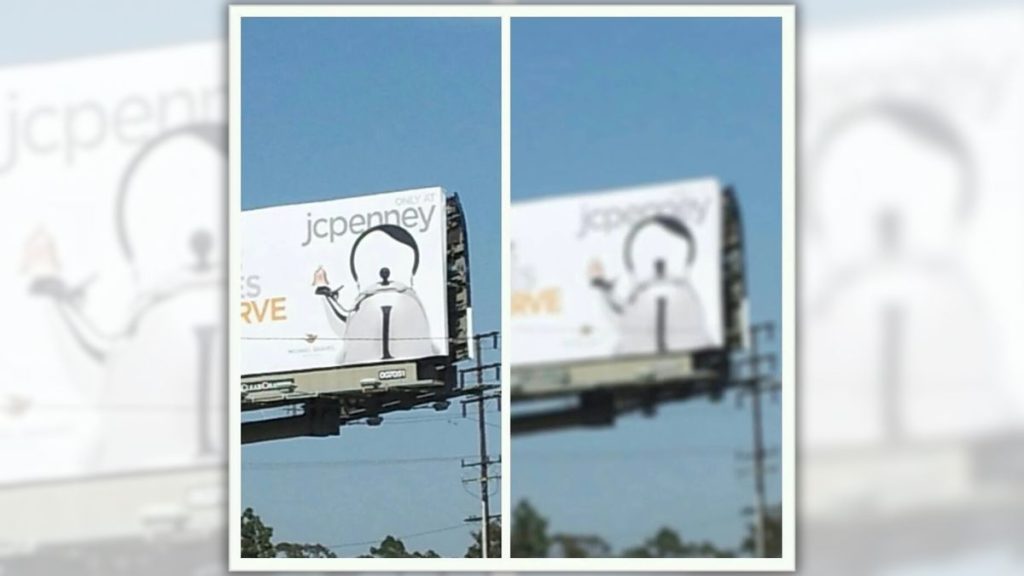Listen to the article
JCPenney’s ‘Hitler Kettle’ Billboard: When Household Design Sparked Controversy
A decade after it first made headlines, the infamous JCPenney tea kettle controversy has resurfaced on social media platforms, reminding the public of one of retail’s most unusual PR incidents.
In 2013, the American department store retailer erected a billboard along the southbound Interstate 405 freeway in Culver City, California, featuring what was intended to be an innocuous stainless steel tea kettle from its Michael Graves collection. The $40 kettle, according to the company’s marketing materials, offered “all the bells and whistles you’ll need—a cool-touch handle, space-saving design and a delightful whistle to let you know when it’s ready to pour.”
What JCPenney hadn’t anticipated was that many passers-by would see something entirely different: a striking resemblance to Nazi dictator Adolf Hitler. The image went viral after a Reddit user posted a photo in the r/LosAngeles subreddit, drawing attention to the kettle’s handle that resembled Hitler’s signature side-parted hairstyle, the lid knob that evoked his mustache, and the spout that appeared raised like an arm giving the notorious Nazi salute.
The resemblance quickly caught the attention of local news outlets, with CBSLA and ABC7 reporting on the peculiar billboard on May 23, 2013. Within days, the story had been picked up by major national and international media organizations, including NPR, Time, The Guardian, Forbes, and The Hollywood Reporter, transforming a simple home goods advertisement into a full-blown viral sensation.
JCPenney, already struggling with falling profits and seeking to rehabilitate its image after a challenging period of leadership changes and declining sales, found itself in an unexpected public relations predicament. The company responded on Twitter (now X), stating the design was “totally unintentional” and quipping, “If we’d designed the kettle to look like something, we would’ve gone w/a snowman.”
The retailer quickly removed the billboard, but not before the controversial kettle had completely sold out on the JCPenney website. The viral attention created such demand that opportunistic resellers listed the item on eBay for as much as $199, nearly five times its original retail price.
Local officials expressed outrage over the billboard. Jeffrey Cooper, then-mayor of Culver City, told Mother Jones: “I am disappointed JCPenney actually put the billboard up in the first place and more outraged that they actually attempted to defend it… As a Jew, I am offended, [and] as an elected official, I am mad that the city I represent is linked to this.”
The Anti-Defamation League, however, took a more measured approach, stating: “JCPenney did the right thing by responding to public concerns and removing the tea pot from their product line… We take JCPenney at their word that any resemblance to the Nazi dictator was completely unintended.”
The incident exemplifies how unintentional design choices can lead to major public relations challenges for retailers. For JCPenney, it came during a particularly difficult period when the company was struggling to redefine its brand identity and recapture market share lost to competitors. While the controversy was short-lived, it has maintained a place in retail and advertising lore, occasionally resurfacing on social media as it has recently.
The kettle incident, sometimes referred to as “Teapotgate,” serves as a cautionary tale for advertisers about the power of pareidolia—the tendency for people to see familiar patterns like faces in inanimate objects—and how quickly unintended imagery can spread in the digital age.
Despite reaching out for comment on the resurgence of this story, JCPenney has not yet offered additional statements about this unusual chapter in its corporate history.
Verify This Yourself
Use these professional tools to fact-check and investigate claims independently
Reverse Image Search
Check if this image has been used elsewhere or in different contexts
Ask Our AI About This Claim
Get instant answers with web-powered AI analysis
Related Fact-Checks
See what other fact-checkers have said about similar claims
Want More Verification Tools?
Access our full suite of professional disinformation monitoring and investigation tools




5 Comments
Interesting how design can spark unintended associations. I wonder if JCPenney should have anticipated the potential Hitler comparisons before putting up that billboard.
Hindsight is 20/20. They likely didn’t foresee the public reaction, but it’s a cautionary tale about being mindful of potential interpretations.
This just goes to show how important visual branding and design can be, especially for major retailers. One small detail can make a big difference in how a product is perceived.
Absolutely. Companies need to carefully vet their designs and marketing to avoid unintended controversies like this. Oversight and focus groups could have helped spot the issue.
The tea kettle controversy is a fascinating case study in how public perception can sometimes override a company’s intent. Consumers can be highly sensitive to certain visual cues.